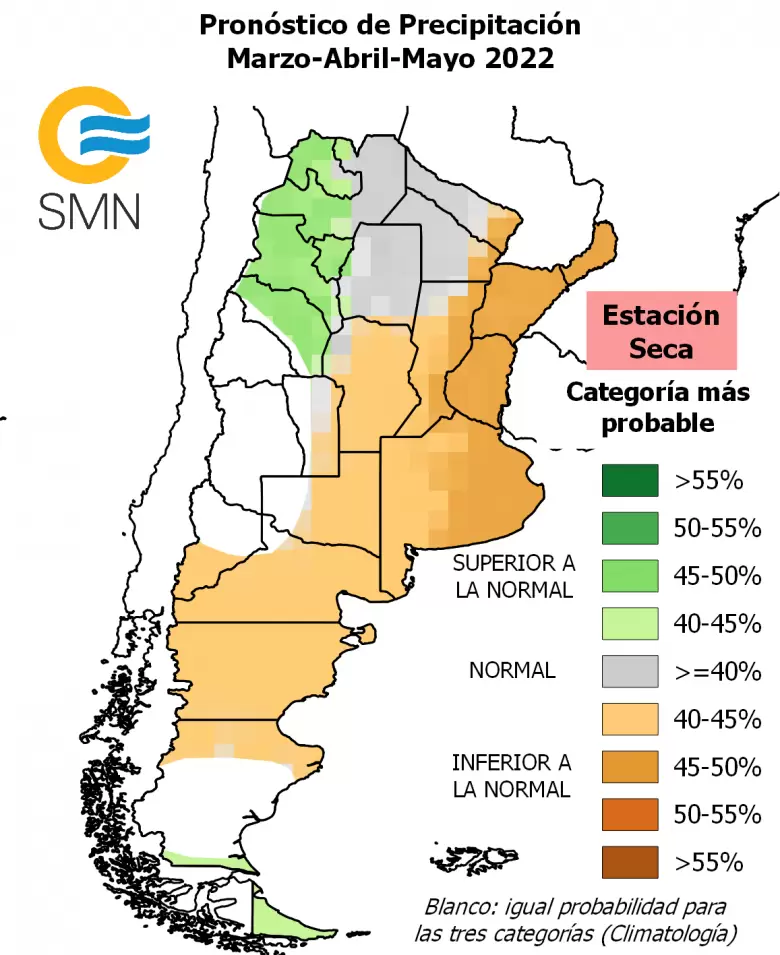A warmer than normal autumn will occur in most of Argentina in the next three months and the lack of rainfall will continue in the Litoral region.hand in hand with the La Nia phenomenon, after going through the third hottest summer in history, according to a study by the National Weather Service (SMN).
The survey indicates that in a large part of the country, except in the provinces of NOA, Cuyo and the extreme south of Patagonia, “normal or above normal” temperatures are expected throughout the rest of the territorywhile the scarcity of rainfall will persist, especially in the Litoral region.
At this point, the report highlights that the rainfall forecast for this quarter is not favorable for the northeast of the country, considering the critical situation of recent months since “the La Nia phenomenon will continue for much of the fall, which has repercussions on the climate of the region. This lack of rain will also affect Entre Ríos and part of the province of Buenos Aires.
On the other hand, there will be excess rainfall in the NOA and southern Patagonia, while the dryness will be milder in Córdoba, western Santa Fe, western Buenos Aires, eastern La Pampa and central-northern Patagonia.

–
–

This behavior of the climate in the country in the next three months will occur after having experienced a February with very high temperatures, higher than normal, especially in the northeast where records were broken in some localities on several occasions.
The cities that broke historical high temperature records in February were Resistencia (43.5), Corrientes (42.8), Formosa (42.8), Mercedes (42.5), Reconquista (42.3), Monte Caseros ( 42.1), Paso de los Libres (41.8), Ituzaing (41.5) and Posadas (40.7).

–
–
Regarding rainfall, several areas of the country such as the north of Patagonia, Cuyo, La Pampa, Buenos Aires, the south of the Litoral and the north and south of the NOA, recorded rains and storms in February, with significant accumulated precipitation.
As an example, the SMN cited Tartagal (Salta), where the accumulated rainfall was 163mm on February 4 and 107mm on February 21.
The summer of 2022 was the third hottest in history, according to the report, which claimed that it was only surpassed by those of the years 1988/89 and 2011/12.
He also indicated that only between January 6 and 26 last “a large part of the center and north of the country registered an event of extreme heat, highlighting its territorial extension, duration and intensity in many cities”
In that period there were dozens of historical records, with temperatures exceeding 40 degrees.
Meanwhile, 69 localities registered a heat wave and the longest duration occurred in the Litoral, which lasted 14 days.
In addition, more than one locality has broken several monthly records since 1961, and also historical records since records have been kept.
In Mar del Plata on January 14, 42.4 degrees were registered, an extreme value for that city, leaving the record of 41.6 registered on January 28, 1957 in second place.
Meanwhile, in the north of the country, in Las Lomitas (Formosa) and Rivadavia (Salta) the frequency of days with maximum temperatures above 40 degrees stood out, with 18 and 19 days respectively, also setting a record, at least since 1961.
Regarding the rains, in the summer of 2022 there was a decrease in the records, with historical records and a very prolonged drought in the northeast of the country.
Extreme heat and low rainfall contributed to devastating fires in the northern Littoral.
In Corrientes, the accumulated precipitation throughout the summer was less than 85 millimeters, when under normal conditions around 500 millimeters should fall.
The cities that had low rainfall records, in addition to Corrientes, were Resistencia (104.1 mm), Las Lomitas (124 mm), Formosa (153.7 mm), Paso de Los Libres (130.6 mm), Posadas (227.2 mm), Ituzaing (170 mm) and Reconquest (157.5 mm).
https://www.youtube.com/watch?v=9m8_a6ZLtJk
–

